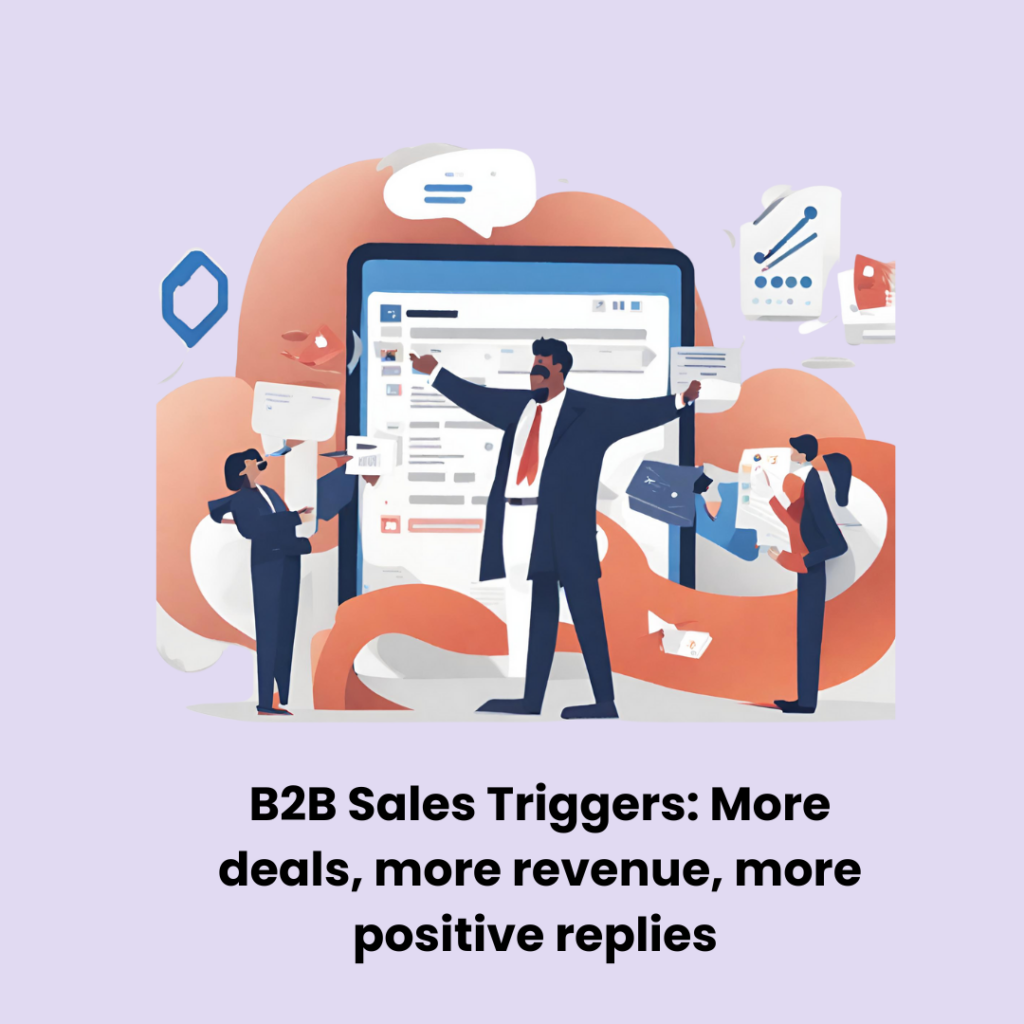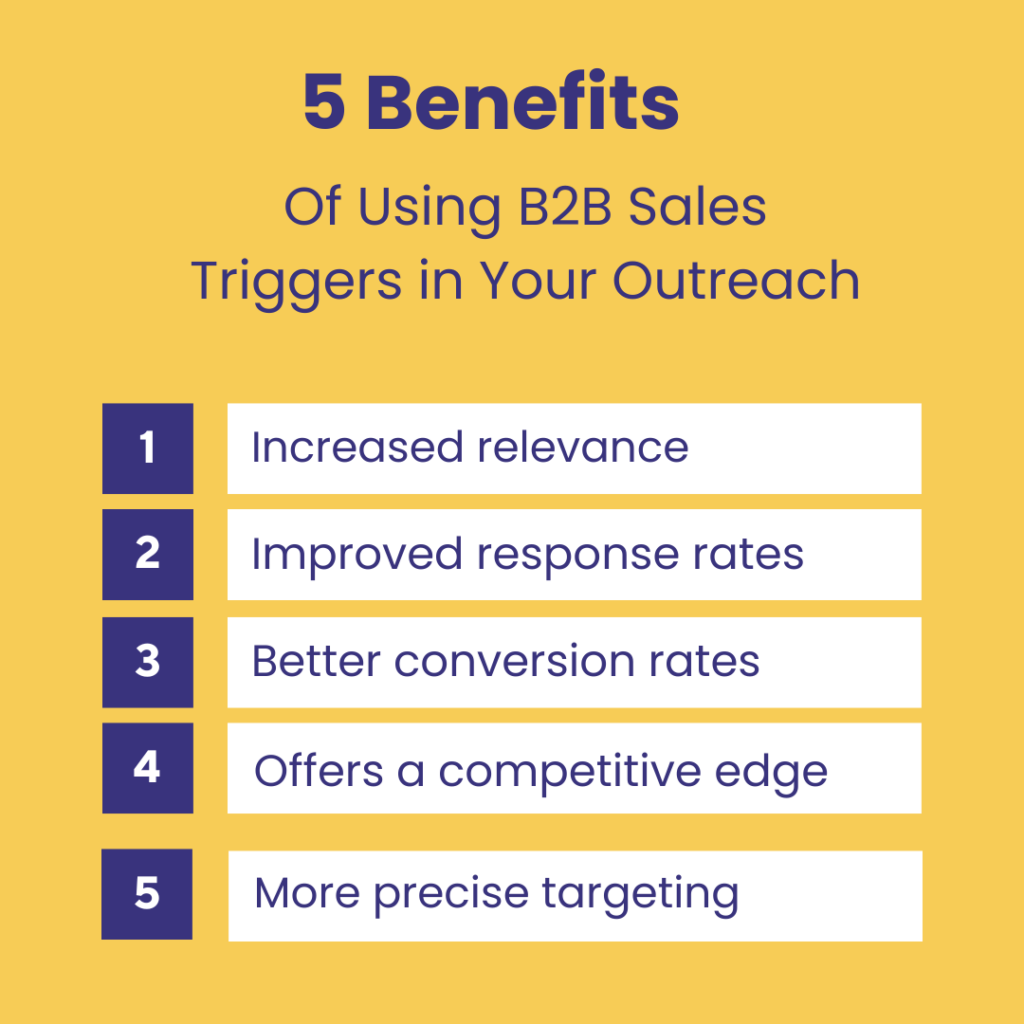Navigating through the world of B2B sales today requires more than just a good product. You could have built the most feature-rich software or service in the market, but it won’t succeed if your sales team cannot effectively reach out to a potential customer at the right time & with the right message.
This is where the use of B2B sales triggers has changed the game, particularly in the context of cold outreach. At a time when decision-makers are bombarded with multiple options and are still time-poor, utilizing B2B sales trigger events can dramatically increase the effectiveness of your pitch.
With timing being key in B2B sales, this article will discuss the role of B2B sales triggers in your outbound efforts, while diving into the benefits & implementation of B2B sales trigger events.
Let’s explore.
What are B2B Sales Triggers?

B2B sales triggers are key events or changes within an organization that indicate potential buying intent or a shift in business needs. Utilizing B2B sales trigger events in your outreach provides insights into the right time for approaching prospects.
For example, a company announcing expansion plans or undergoing a merger presents a unique opportunity for tailored sales triggers cold outreach.
Sales managers can leverage sales trigger events if they fully understand their ICP, have in-depth insight about their purchasing behavior and tailor their outreach accordingly.
Why Should You Use B2B Sales Triggers?

The use of B2B sales triggers not only enhances the relevance of your outreach but also significantly impacts your overall sales performance. According to a Forrester report, B2B marketers who incorporate these triggers into their email marketing strategies see an average increase of 20% in sales opportunities.
Here are some reasons why you should implement B2B sales triggers in your outreach:
1. Increased relevance
B2B sales trigger events significantly enhance the relevance of outbound strategies by aligning sales efforts with the specific, evolving needs of prospects. For instance, when a company undergoes a major change, like a merger or leadership shift, its priorities and requirements change.
Tailoring your outreach to these specific scenarios ensures that your message addresses current challenges, making it highly pertinent. As per a study, trigger-based emails contribute 20% of all email marketing revenue, with over 45% marketers using them in their email marketing efforts.
This alignment not only increases effectiveness but also positions your business as a responsive and insightful partner in the B2B sector.
2. Improving response rates
B2B sales triggers have a significant impact on increasing response rates in outbound strategies by ensuring that communication is highly relevant and timely. When a sales outreach coincides with a significant event in a prospect’s business – such as a funding round, a major project announcement, or a shift in strategic direction – it speaks directly to the current needs or situation of the company.
This targeted approach means that the prospect is more likely to see the outreach as immediately valuable and pertinent, leading to a higher likelihood of engagement.
3. Better conversion rates
When your outreach aligns with a B2B sales trigger, like a company receiving new funding or launching a new product, it aligns with the prospect’s immediate priorities. This timing means your solutions are presented when the company is most likely considering such investments.
This further leads to more meaningful sales conversations, with B2B sales trigger events leading to 74% better win rates and conversions.
4. Competitive edge
Many competitors might still be using generic, untargeted methods. By employing B2B sales triggers in your approach, you differentiate your company as more insightful and attuned to the current market and individual company dynamics.
You can act on opportunities faster, and position yourself ahead of competitors who might not be monitoring the triggers as closely as you.
Remember; being the first to provide a solution or to initiate a conversation during these pivotal moments can establish your company as a proactive and attentive partner, potentially leading to stronger business relationships and a higher chance of securing the deal.
5. More precise targeting
Targeting prospects based on B2B sales triggers such leadership changes or market expansion can be an effective way to get conversions. While casting a wide net of prospects is a general recommendation, you get the best results when you’re more narrowed down in your prospecting efforts.
This focused approach further allows you to allocate resources more effectively, and spend more time reaching out to prospects who have a higher likelihood of being interested in your offerings.
In addition to the above, here are some interesting stats shared by Craig Elias as part of his ‘Trigger Event Selling’ approach, which outline the effectiveness of B2B sales trigger events in outbound success:
- SDRs who use B2B sales triggers achieve 20% more of their monthly sales quota
- Marketers who act on B2B sales trigger events report 80% more savings in their direct marketing costs
- About 63% of the top firms currently use some sort of B2B sales trigger tracking tools, including notifications, RSS feeds and Google Alerts among others.
If these numbers are anything to go by, using B2B sales triggers is crucial in 2024, with the B2B buying behavior expected to become more complex and timing-driven.
Common Sales Triggers Examples
Now that we’ve discussed the benefits of using B2B sales triggers, let’s now look at a few examples and how you can track them without much effort.
Here is a quick B2B sales trigger list of some common examples for you to understand their utility better:
1. Appointment of C-Suite Executives
When a company announces the appointment of new C-suite executives, it often signals a shift in strategy and openness to new ideas. These high-level changes can lead to a review of existing vendor relationships and openness to new partnerships.
Since they haven’t established themselves within the company yet, it makes them more open to new ideas & perspectives which help prove their value.
This scenario presents a prime opportunity for using B2B sales triggers for cold outreach, as new executives may be more receptive to innovative solutions that align with their fresh goals and perspectives.
How-to track them? – You can use LinkedIn Sales Navigator to check executives who’ve changed their jobs in the past 90 days. In addition, you can also follow your contacts on LinkedIn and see if they match your ICP and have moved into new roles.
2. Mergers & Acquisitions
Mergers and acquisitions often result in a comprehensive reassessment of business strategies, processes, and tools. This period of transition is critical for companies to realign their resources, potentially leading to new requirements for products or services.
As per a report by Nasdaq, the outlook for M&A activity in 2024 will be more promising, despite the economic uncertainty and geopolitical situations.
For B2B marketers, this underscores the importance of staying vigilant about such B2B sales triggers and capitalizing on new business opportunities that this M&A activity is expected to bring up.
How to track them? – To track M&A-related sales trigger events, you can either keep track of deals on platforms like Flippa and Acquire or set up Google Alerts for “your industry + mergers” and “your industry + acquisition”.
One could also keep track of M&A activity through news portals & press releases.
3. New Technology Installs
The installation of new technology within a company is a clear indicator of its readiness to embrace change and modernization. This could range from updating IT infrastructure to adopting new software solutions.
Gartner’s research shows that IT spending is projected to grow at about 8% in 2024, suggesting a continuous demand for new tech solutions.
As the adoption of new-age tools increases in businesses across sectors, B2B companies will be able to leverage new technology installs as B2B sales triggers for cold outreach.
How to track them? – To track new technology installs, you can use tools like BuiltWith in addition to setting up Google Alerts for specific keywords related to technology installations in your target industry.
4. Company expansion
Expansion, whether in terms of physical footprint, market reach, or workforce, typically brings along a set of new challenges and requirements. This could include scaling of operations, entering new markets, or enhancing employee skills.
As per a recent analysis by Powerlinx.com, cross-border expansion & product diversification will be the primary business objectives over the coming quarter.
Such expansions are significant B2B sales triggers, and could indicate a company’s need for additional resources, services, or expertise to support its growth trajectory.
How to track them? – Use tools like Visualping to track changes in the “Contact Us” section of websites, apart from setting up search strings for things like “company plans to expand” or “announces new building” and so on.
You can also use RSS readers like Feedly to collect information about your prospects through the latest articles and monitor them for any expansion-related news.
5. New job posts
An increase in job postings, especially in new or rapidly growing departments, can be indicative of a company’s expansion or strategic shift. These postings can reveal areas where the company is investing, such as new technologies or market development.
Such job postings often serve as a leading indicator of corporate growth, making them ideal B2B sales trigger events for companies offering solutions that align with these emerging needs.
How to track them? – You can use tools like LinkedIn or even scrape information from sites like Indeed, ZipRecruiter and Monster.com by using a scraper.
6. Fundraising
Fundraising events, particularly in startups or growth-stage companies, often signal an influx of capital earmarked for new projects, expansion, or technology upgrades.
These events are crucial sales trigger events, as they represent a period when companies might be more open to investing in new solutions or partnerships to fuel their growth plans.
Once you’ve got this information, reach out to them confidently & demonstrate how you can help them meet specific objectives.
How to track them? – You can follow company filings, share price fluctuations and analyst reports to track funding-related events. One can also use tools like Crunchbase & LinkedIn to track new fundraising events.
7. Change of roles
You can still prospect & build a relationship with decision-makers who might have recently changed their job role or title. This is because the move might create new opportunities for you in case they stay within the organization, and can extend the use of your product or service in their new position and department.
Even if they change companies, you can still offer them the solution, albeit ensuring that it’s tailored to the needs of the new organization.
How to track them? – You can monitor the prospect’s social media & follow industry news for updates on such types of B2B sales triggers.
8. Major industry developments
Following major industry developments can be yet another type of B2B sales triggers that you can use in your outreach. Every year, there are certain events or policy changes which take place in almost every industry.
As a result, many of the companies in that industry end up looking for solutions that could either solve or at least mitigate these changes for the time-being.
Now while it’s hard to know what your buyers’ priorities are, or even how they’ve navigated through the last major development, you can still use these B2B sales trigger events to personalize your outreach.
How to track them? – You can set up alerts on LinkedIn and Google for information around any new industry developments and also follow social media posts from major industry publications.
How to track sales trigger events?
Effective utilization of B2B sales triggers in cold outreach demands timely awareness of these events.
Here’s how you can track them:
- Social media monitoring: Platforms like LinkedIn are often the first to announce significant organizational changes, providing timely insights into potential B2B sales triggers. You can also use tools like Mention, BuzzSumo and others to keep track of what’s being talked about in your industry on social media.
- Google Alerts: Setting up alerts for specific companies or industry keywords can keep you informed about relevant events and news. Once you’ve set up a Google Alert for either of these, you’ll be notified via email as soon as the company’s name is mentioned in the news.
- Industry Newsletters: Regularly reading industry-specific newsletters can provide early indications of market shifts and organizational changes, which are invaluable as B2B sales triggers when timing your outreach accordingly.
- Email Engagement Tracking: Monitoring how recipients interact with your emails can offer insights into their current interests and potential readiness for your solutions.
In addition to the above, you can also track company websites, blogs, commercial registers and databases for insights around specific B2B sales triggers.
You can also use AI tools like Clay and Bardeen.ai to set up relevant B2B sales triggers and prepare a highly-targeted, intent-based prospecting list.
How to Use Sales Triggers in Cold Outreach?
While manually including B2B sales triggers in your cold outreach is a viable option, it’s more than just about timing when it comes to using these events for your outreach. It’s also about context and personalization.
Thankfully with AI, you can not only automate the discovery of these sales triggers, but also the way they’re being implemented in your outbound efforts. We recently wrote an article that’ll help you get started with using AI-based sales triggers in your outreach.
It’s highly recommended that you check it out for in-depth insights about using sales triggers in your cold outreach campaigns.
Personalization based on these sales-related events will not only increase the chances of a positive reply, but also showcase your commitment to offering prospects with relevant solutions.
Final Thoughts
To sum up, mastering the use of B2B sales triggers is crucial for modern B2B sales and outreach success. Implementing them in your strategies can significantly enhance your outreach’s effectiveness, making your interactions more timely, relevant, and ultimately more successful.
Now, if you’re a B2B business that’s looking to leverage these sales triggers in your outreach, drop us a line on [email protected].
At Cleverviral, we not only specialize in using B2B intent data, but also the usage of trigger-based insights to equip B2B companies with the necessary tools and techniques to elevate your outreach to the next level.
Until then, happy prospecting!
Frequently Asked Questions
How do you track sales triggers?
– Follow industry news
– Use social media listening tools
– Subscribe to industry newsletters
– Use Google Alerts
You can also use CRM software integrated with real-time market intelligence platforms for timely insights into significant sales events like mergers & acquisitions, leadership changes and financial milestones within target organizations.
Why are sales triggers important?
By identifying these triggers, sales teams can tailor their approach to be more relevant and impactful, increasing the likelihood of successful engagement and conversion.






